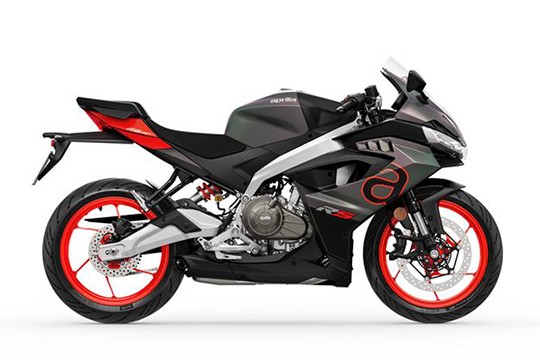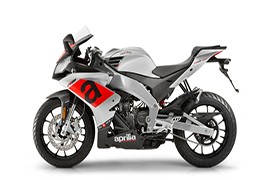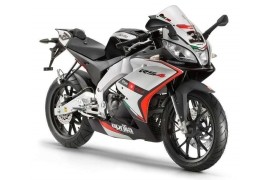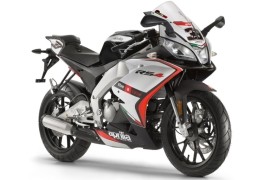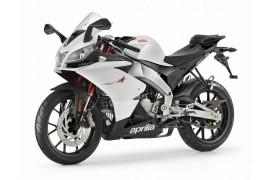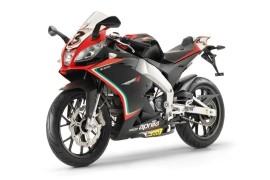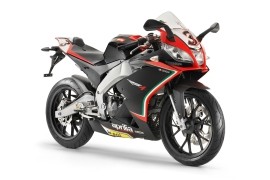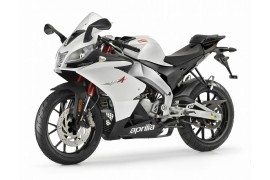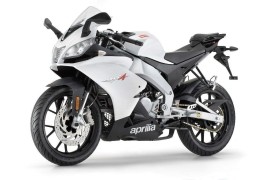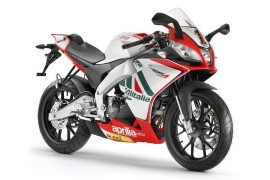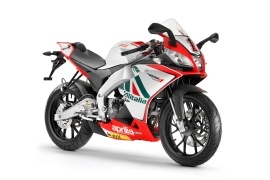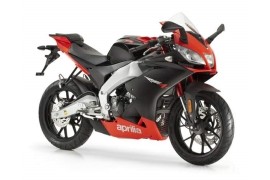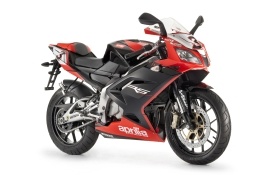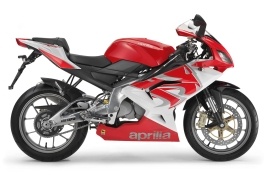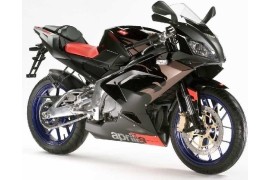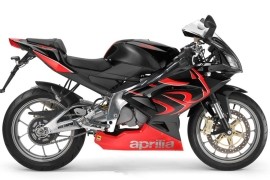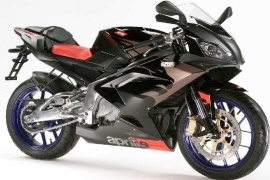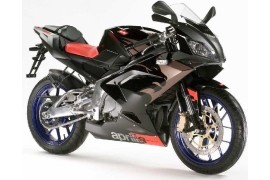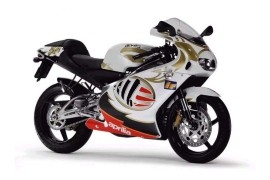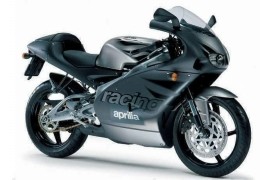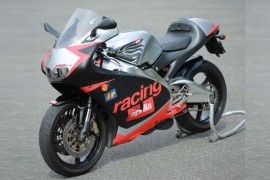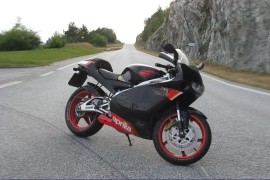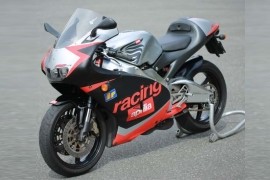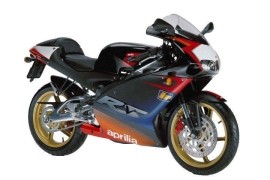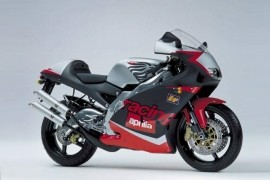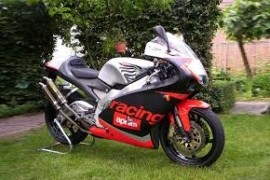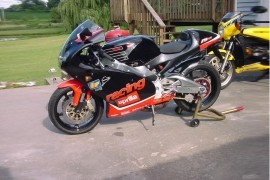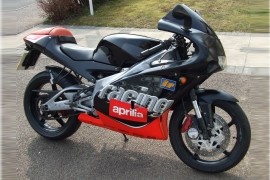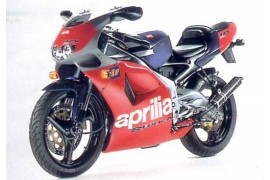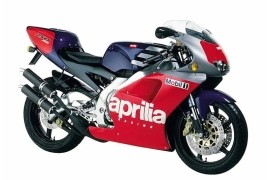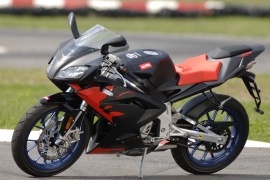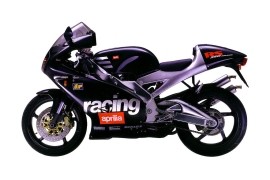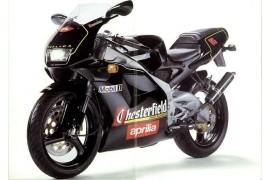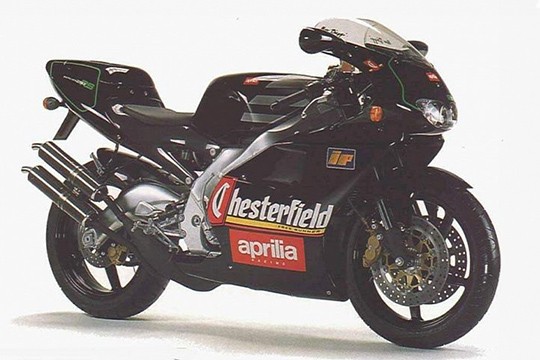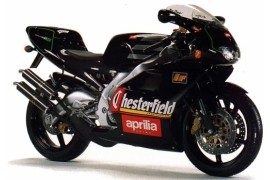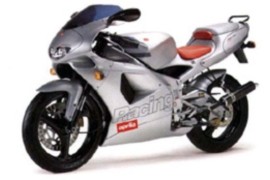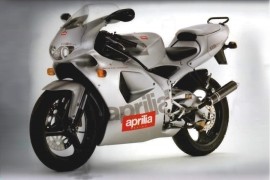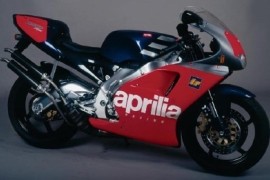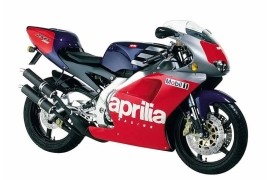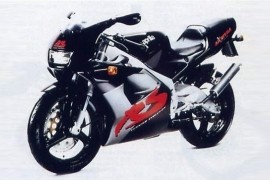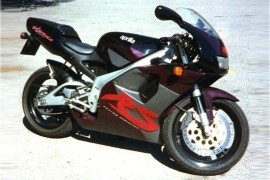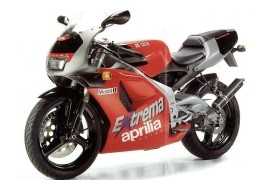APRILIA RS Models/Series Timeline, Specifications & Photos
First production year: 1992
Aprilia is an Italian motorcycle manufacturer based in Noale, Italy, founded right after World War Two by Alberto Beggio. At first, the company manufactured bicycles and then moved to scooters and small-capacity motorcycles.
In 2023, the Italian motorcycle manufacturer launched the Aprilia RS 457, a motorcycle referred to as the "new technological and stylistic benchmark" developed for the youngest among riders but featuring the best power-to-weight ratio in its class.
The bike's aesthetic is represented by a full fairing with a dual headlight system, a small windscreen, a two-piece dual seat, a two-into-one under-belly-mounted exhaust system, and lightweight six-spoke red-finished wheels.
The 2023 Aprilia RS 457 had installed underneath its fuel tank a four-stroke liquid-cooled twin-cylinder fed by an electronically-controlled fuel injection system, delivering 48 hp, the most power legally allowed for an A2 license motorcycle.
The bike was built around a lightweight aluminum frame with a 41 mm inverted fork on the front with 120 mm wheel travel and a single shock absorber on the rear with 130 mm wheel travel, offering excellent suspension performance and handling.
On the front end, the RS 457 had installed a dual LED headlight system, delivering the usual Aprilia signature, integrated turn signals, and a 5-inch TFT screen. The bike is dressed in an aggressive bodywork and wrapped in a race-inspired color scheme.
The Aprilia RS4 125 was a 125cc class sports bike manufactured by Aprilia in 2012 to replace the popular RS 125 two-stroke made from 1992 to 2012. The RS4 125 was based on the four-stroke version of the Derbi GPR125.
Between 1992 and 1995, the motorcycle packed an angular tail section, a swept front fairing, a square headlight, three-spoke wheels, an electric starter or kickstart, and analog gauges.
In 1996, the bike had its first revision that included a new, improved Rotax 122 engine, air intakes integrated into the upper portion of the middle fairing, a rounded headlight, and a digital gauge in place of the temperature gauge. In addition, the "Extrema" designation was dropped.
In 1999, a revised version of the model was released, which included modifications, such as more rounded and bulbous fairings, a single air duct on the right-hand side, a larger lip on the headlight, and five-spoke rims.
In 2012, the line was dropped to make way for the new Aprilia RS4 125, a model that packed a new four-stroke single-cylinder fuel-injected Rotax engine instead of the previous two-stroke unit.
In 2017, the Italian motorcycle maker released the Aprilia RS 125. It was renamed to celebrate 25 years of the RS model. It was EURO4 compliant, had a USB port, a storage compartment that could fit a six-inch tablet, and three headlights.
The 2017 Aprilia RS 125 had installed a 124cc four-stroke liquid-cooled single-cylinder engine underneath its fairing, boasting 16 hp at 10,500 rpm and 11 Nm (8 lb-ft) torque at 8,500 rpm.
The Aprilia RS 125 was a Grand Prix-derived, small displacement sports production replica made by Aprilia in 1992 to replace the Aprilia AF1. It was produced until 2010, when it was replaced by the Aprilia RS4 125.
It started as the Aprilia RS 125 Extrema and was made until 1996 when the maker dropped the "extrema" designation. Over its production period, the bike had several revisions, like the one in 1996, 1999, and 2006. The RS 125 was dropped in 2012 in favor of the new RS4 125 model.
In 2014, the Italian motorcycle manufacturer released the Aprilia RS4 125, a small-displacement motorcycle in its third consecutive production year. It packed the same characteristics as the previous one without modifications.
The bike's visual department was characterized by standard fittings, like a dual headlight system, a small windscreen, a two-piece dual seat, a single exhaust system with a silencer mounted on the right-hand side, and multi-spoke alloy wheels.
Some notable features of the 2014 RS4 125 included the new four-stroke Rotax engine, a super rigid aluminum frame and swingarm derived from Aprilia's GP program, RSV 1000 R-styled fairing, windscreen, and tail, and RSV Factory-styled crossed spoke alloy wheels.
As for the power figures, the 2014 Aprilia RS4 125 had its heartbeat set by a 124cc four-stroke single-cylinder liquid-cooled engine that delivered an output power of 16 hp at 10,500 rpm and 11 Nm (8 lb-ft) torque at 8,500 rpm.
In 2014, the Italian bike maker released the Aprilia RS4 50 Replica, a motorcycle which, unlike previous models, came with a race-derived color scheme and "33" Marco Melandri decals, all at the same price as the base model.
The bike's appearance was characterized by standard features, such as a full fairing, three headlights, an aggressive design with several decals, a single exhaust system with a silencer mounted on the right-hand side, and six Y-shaped spoke wheels.
The race-derived motorcycle was built around an aluminum frame with a 41 mm inverted telescopic fork on the front, offering 110 mm of travel, and an asymmetric swingarm with a monoshock on the rear, providing 130 mm of travel.
As for power, the 2014 Aprilia RS4 50 Replica took its muscles from a 49cc two-stroke liquid-cooled single-cylinder engine paired to a six-speed manual transmission and a final chain drive that pushed the motorcycle to 97 kph (60 mph).
From top speed to a complete stop, the motorcycle relied on a 300 mm stainless steel rotor mounted on the front wheel with a four-piston caliper and a 218 mm brake disc on the rear wheel coupled to a single-piston caliper.
The bike was also available with an option called Aprilia Quick Shift (AQS), a technical solution borrowed from the RSV4 model that allowed the rider to reach a higher gear without using the clutch, making it easier and faster to change gears.
The Aprilia RS4 125 was a 125cc class sports bike manufactured by Aprilia in 2012 to replace the popular RS 125 two-stroke made from 1992 to 2012. The RS4 125 was based on the four-stroke version of the Derbi GPR125.
In 2013, the Italian motorcycle maker released the Aprilia RS4 125, a sports-oriented entry-level motorcycle in its second production year, packing a four-stroke single-cylinder fuel-injected engine instead of the previous two-stroke carburated one.
The bike came with standard features, such as a full fairing with a dual headlight system, a small windscreen, a two-piece dual seat, a single exhaust system with a silencer mounted on the right-hand side, and multi-spoke alloy wheels.
For suspension, the motorcycle packed a 41 mm inverted telescopic fork on the front with 110 mm of travel and a single shock absorber on the rear with 130 mm of travel, providing optimum suspension performance and handling capabilities.
In the braking department, the motorcycle's wheels were fitted with a 300 mm brake disc tied to a four-piston caliper on the front and a 218 mm brake disc on the front coupled to a single-piston caliper on the rear.
As for the power figures, the 2013 Aprilia RS4 125 had its soul brought to life by a 124cc four-stroke liquid-cooled single-cylinder engine mounted at its core, delivering 16 hp with a peak force at 10,500 rpm and 11 Nm (8 lb-ft) torque at 8,500 rpm.
The Aprilia RS4 50 was a small displacement sports motorcycle created by Italian engineers for the youngest among Aprilia fans. The bike had a unique look with the headlights mounted above the air intake and set new standards in style and technical content.
In 2013, the Italian motorcycle manufacturer released the Aprilia RS4 50, the smallest displacement machine of the family. The 2013 model packed the same technical, visual, and performance specifications as the previous one without any modifications.
The bike had standard features in the visual department, such as a three-headlight system, a small windscreen, a two-piece dual seat, a single exhaust system, a dual-sided swingarm, and Y-shaped multi-spoke wheels.
Suspension-wise, the bike packed a 41 mm inverted fork on the front, providing 110 mm of travel, and a single shock absorber on the rear with 122 mm of travel, offering excellent suspension performance and handling capabilities.
As for the stopping power, the motorcycle's wheels were fitted with a 300 mm stainless steel brake rotor mounted on the front and coupled to a four-piston radial caliper. In contrast, the rear consisted of a 218 mm stainless steel disc tied to a single-piston caliper, offering excellent stopping power.
Regarding power, the 2013 Aprilia RS4 50 had its heartbeat set by a 49cc two-stroke liquid-cooled single-cylinder engine mounted underneath its fuel tank. It was married to a six-speed transmission and a final chain drive, spinning the rear wheel to 97 kph (60 mph).
The 2013 MY Aprilia RS4 125 Biaggi Racing Replica has been designed with a paint and graphic scheme similar to the one used on Max Biaggi's official Superbike Championship machine, and is sure to turn heads no matter where one rides it.
In all other departments, it has the same features as the base RS4 125, as well as the engine, a liquid-cooled, four-stroke, 124cc, single cylinder powerhouse mated to a six-speed manual transmission, that can reach a maximum power output of 16 horsepower and 11 Nm of torque.
In 2012, the Italian motorcycle maker released the Aprilia RS4 125, a sports-oriented entry-level motorcycle in its first production year, which replaced the previous Aprilia RS 125. The 2012 model packed a four-stroke single-cylinder fuel-injected engine instead of the previous two-stroke carburated one.
The bike had standard features, such as a full fairing with a dual headlight system, a small windscreen, a two-piece dual seat, a single exhaust system with a silencer mounted on the right-hand side, and multi-spoke alloy wheels.
In the power department, the 2012 Aprilia RS4 125 had installed a 124cc four-stroke liquid-cooled single-cylinder engine that delivered an output power of 16 hp with a peak force at 10,500 rpm and 11 Nm (8 lb-ft) torque at 8,500 rpm.
The power generated by the engine was controlled by a six-speed transmission with a wet multi-disc clutch and sent to the rear end via a final chain drive.
Suspension-wise, the motorcycle packed a 41 mm inverted telescopic fork on the front with 110 mm of travel and a single shock absorber on the rear with 130 mm of travel, providing optimum suspension performance and handling capabilities.
As for the stopping power, the bike's wheels were fitted with a 300 mm brake disc tied to a four-piston caliper on the front and a 218 mm brake disc on the front coupled to a single-piston caliper.
In 2012, the Italian motorcycle maker released the Aprilia RS4 50, the smaller sister of the RS4 125 model. It was a real bike designed with the same care and professionalism as the larger Aprilia bikes.
The Aprilia RS4 50 was a small displacement sports replica created by Italian engineers for the youngest among Aprilia fans. The motorcycle had a unique look with the headlights mounted above the air intake and set new standards in style and technical content.
The 2012 model came in the same shape and form as the previous one, delivering the same technical, performance, and visual characteristics without any significant modifications whatsoever.
The 2012 Aprilia RS4 50 was set in motion by a 49cc two-stroke liquid-cooled single-cylinder engine mounted underneath its fuel tank. Its power was sent to the rear wheel through a six-speed transmission and a final chain drive, pushing the motorcycle to a top speed of 97 kph (60 mph).
The bike had standard features, such as a full fairing, a three-headlight system, a small windscreen, a two-piece dual seat, a single exhaust system, a dual-sided swingarm, and Y-shaped multi-spoke wheels.
The bike's riding experience was handled by a 41 mm inverted fork on the front, providing 110 mm of travel, and a monoshock on the rear with 122 mm of travel, providing excellent suspension performance and handling capabilities.
Unlike the base RS4 125 takes the racing experience of the bike to the next level, boasting a paint and graphic scheme similar to the one found on Noale's official Superbike Championship machine. In all other aspects, it has the same features as the base model.
At its heart lies a liquid-cooled, four-stroke, 124cc, single cylinder powerhouse mated to a six-speed manual transmission, and can produce a claimed 16 horsepower and 11 Nm of torque.
The Aprilia RS4 50 was a small displacement sports replica created by Italian engineers for the youngest among Aprilia fans. The motorcycle had a unique look with the headlights mounted above the air intake and set new standards in style and technical content.
In 2011, the Italian motorcycle maker released the Aprilia RS4 50, which featured the same technical, visual, and performance specifications as the previous one without any significant modifications.
It was manufactured around an aluminum frame with a 41 mm inverted telescopic fork on the front, providing 110 mm of travel. An asymmetric swingarm with a single shock absorber on the rear offered 122 mm of travel, delivering excellent suspension performance and handling.
The bike was kept on the safe side by a 300 mm stainless steel brake disc on the front coupled to a four-piston radial caliper and a 218 mm stainless steel disc on the rear tied to a single-piston caliper, offering excellent stopping power.
As for power, the 2011 Aprilia RS4 50 had installed a 49cc two-stroke liquid-cooled single-cylinder engine underneath its fuel tank. The power generated by the engine was redirected to the rear end via a six-speed transmission and a final chain drive, spinning the rear wheel to 97 kph (60 mph).
The bike's visual department was characterized by standard fittings, such as a full fairing, a three-headlight system, a small windscreen, a two-piece dual seat, a single exhaust system, a dual-sided swingarm, and Y-shaped multi-spoke wheels.
In 2011, Aprilia released the RS 125, an entry-level small displacement sports motorcycle created for the youngest and less experienced Aprilia fans and the more seasoned ones who wanted a more agile machine.
The 2011 motorcycle packed the same characteristics as the previous one, including technical, visual, and performance specifications, without any significant modifications whatsoever.
The bike's last revision occurred in 2006, when it received a new fairing similar to the one of the RSV1000R, with an angular design, two headlight bulbs, a digital gauge, and multi-spoke wheels created by Marchesini.
The bike packed standard fittings like a full fairing, a medium-sized windscreen, a two-piece dual seat with a rider lumbar support, a single exhaust system with a muffler mounted on the left-hand side, and multi-spoke wheels.
The motorcycle packed a 40 mm upside-down telescopic fork on the front and a spring preload-adjustable hydraulic monoshock on the rear, offering optimum suspension performance and handling capabilities.
As for the braking power, a 320 mm floating brake disc with a four-piston caliper on the front and a 220 mm brake rotor with a two-piston caliper mounted on the rear offered optimum stopping power.
As for the power figures, the 2008 Aprilia RS 125 was set in motion by a 124cc two-stroke liquid-cooled single-cylinder engine that delivered 33 hp.
In 2010, the Italian motorcycle maker released the Aprilia RS4 50, a small-displacement sports replica created by Italian engineers for the youngest Aprilia fans. The RS4 125 was the first sports bike with a four-stroke engine for 16-year-old riders.
Visually, the motorcycle packed standard features, such as a full fairing, a three-headlight system, a small windscreen, a two-piece dual seat, a single exhaust system, a dual-sided swingarm, and Y-shaped multi-spoke wheels.
The small bike was built around an aluminum frame with a 41 mm inverted telescopic fork on the front that provided 110 mm of travel and an asymmetric swingarm with a single shock absorber on the rear that offered 122 mm of travel.
As for the braking performance, the bike's wheels were fitted with a 300 mm stainless steel brake disc on the front and a 218 mm stainless steel disc on the rear. The front was coupled to a four-piston radial caliper, and the rear was tied to a single-piston caliper, offering excellent stopping power.
In the performance department, the 2010 Aprilia RS4 50 had its soul brought to life by a 49cc two-stroke liquid-cooled single-cylinder engine managed by a carburetor. The engine was married to a six-speed manual transmission that sent the power to the rear wheel through a final chain drive, launching the motorcycle to a top speed of 97 kph (60 mph).
The Aprilia RS 125 was a Grand Prix-derived, small displacement sports production replica produced by Aprilia in 1992 to replace the Aprilia AF1. It was produced until 2010, when it was replaced by the Aprilia RS4 125.
In 1996, the bike had its first revision that included a new, improved Rotax 122 engine, air intakes integrated into the upper portion of the middle fairing, a rounded headlight, and a digital gauge in place of the temperature gauge. In addition, the "Extrema" designation was dropped.
In 1999, a revised version of the model was released, which included modifications, such as more rounded and bulbous fairings, a single air duct on the right-hand side, a larger lip on the headlight, and five-spoke rims.
In 2006, the bike was again revised, packing a new fairing similar to the one of the RSV1000R, with an angular design, two headlight bulbs, a digital gauge, and multi-spoke wheels created by Marchesini.
In 2009, the Italian motorcycle maker released the Aprilia RS 125, a motorcycle with the same package as the previous one, delivering the same characteristics without modifications.
The 2009 Aprilia RS 125 was fitted with standard features, such as a full fairing, a medium-sized windscreen, a two-piece dual seat with a rider lumbar support, a single exhaust system with a muffler mounted on the left-hand side, and multi-spoke wheels.
In 2008, the Italian motorcycle maker released the Aprilia RS 125, an entry-level small displacement sports motorcycle created for the youngest and less experienced Aprilia fans and the more seasoned ones who wanted a more agile machine.
The 2008 model came with the same package as the previous one, delivering the same visual, technical, and performance specifications without any significant modifications whatsoever.
The Aprilia RS 125 was a Grand Prix-derived, small displacement sports production replica made by Aprilia in 1992 to replace the Aprilia AF1. It was produced until 2010, when it was replaced by the Aprilia RS4 125.
The bike's aesthetic department was characterized by standard features, such as a full fairing, a medium-sized windscreen, a two-piece dual seat with a rider lumbar support, a single exhaust system with a muffler mounted on the left-hand side, and multi-spoke wheels.
For suspension, the motorcycle packed a 40 mm upside-down telescopic fork on the front and a spring preload-adjustable hydraulic monoshock on the rear, offering optimum suspension performance and handling capabilities.
The braking power was achieved by a 320 mm floating brake disc and a four-piston caliper on the front and a 220 mm brake disc with a two-piston caliper mounted on the rear, providing optimum stopping power.
As for the power figures, the 2008 Aprilia RS 125 boasted 33 hp from a 124cc single-cylinder two-stroke liquid-cooled engine coupled to a six-speed transmission.
The 2007 MY Aprilia RS 125 R sports a liquid-cooled, two-stroke, 124cc, single cylinder engine paired to a six-speed manual transmission, and can produce a claimed 28 horsepower and 19 Nm of torque. This machine comes standard with lightweight, Marchesini, cast-aluminium wheels, a race-derived, aerodynamic full-fairing, a large, 320mm front disc brake with a 4-piston caliper, an inverted fork as a front suspension and an adjustable monoshock in the rear, plus a small windscreen.
The 2007 MY Aprilia RS 125 Nero sports a liquid-cooled, two-stroke, 124cc, single cylinder lump mated to a six-speed manual transmission and can produce a claimed 28 horsepower and 19 Nm of torque. This blacked-out entry-level machine addresses the younger and less-experienced among Aprilia fans that want an aggressive, edgy look on their race-inspired two-wheeler. Standard features include an upside-down fork in the front, an adjustable monoshock in the rear, lightweight, cast-aluminium wheels, an aluminium frame, a large, 320mm front disc brake, and boasts a dry weight of just 142 kg (323 pounds).
The Aprilia RS 125 was a Grand Prix-derived, small displacement sports production replica made by Aprilia in 1992 to replace the Aprilia AF1. It was produced until 2010, when it was replaced by the Aprilia RS4 125.
In 2006, the Italian motorcycle maker released the Aprilia RS 125, an entry-level machine derived from Aprilia's Moto GP racing program. It was created for the youngest and less experienced Aprilia fans and the more seasoned ones who wanted a more agile machine.
In 2006, the bike was again revised, packing a new fairing similar to the one of the RSV1000R, with an angular design, two headlight bulbs, a digital gauge, and multi-spoke wheels created by Marchesini.
Visually, the bike packed standard features, such as a full fairing, a medium-sized windscreen, a two-piece dual seat with a rider lumbar support, a single exhaust system with a muffler mounted on the left-hand side, and multi-spoke wheels.
The bike's front end was controlled by an inverted telescopic fork and a 320 mm brake disc with a four-piston caliper, while the rear end was handled by an adjustable monoshock and a 220 mm brake disc with a dual-piston caliper.
As for power, the 2006 Aprilia RS 125 had its soul brought to life by a 124cc two-stroke single-cylinder liquid-cooled engine that delivered an output power of 28 hp at 10,500 rpm and 19 Nm (14 lb-ft) torque at 9,000 rpm.
The 2006 MY Aprilia RS 125 R is an entry-level machine derived directly from the Italian brand's MotoGP racing department, and addresses younger, inexperienced riders and more seasoned ones that prefer a more agile machine, alike. It comes standard with an inverted front fork, and adjustable monoshock as a rear suspension, a sing,e 320mm front brake disc with a 4-piston caliper, a dual headlight and a full, aerodynamic fairing.
In the tech/engine department, it sports a liquid-cooled, two-stroke, 124cc, single cylinder powerhouse paired to a six-speed manual transmission and can reach a maximum power output of 28 horsepower and 19 Nm of torque.
The 2006 MY Aprilia RS 125 Poggiali Replica sports a liquid-cooled, two-stroke, 125cc, single cylinder powerhouse paired to a six-speed manual transmission, and can reach a maximum power output of 28 horsepower and 19 Nm of torque.
This machine boasts a special paint scheme in honor of Manuel Poggiali, a Sanmarinese Grand Prix motorcycle racer, who won the 2001 125cc World Championship. In addition to the paint-scheme which was copied from the official Grand Prix motorcycle, it boasts standard features such as a 40mm upside-down fork, a rear, adjustable monoshock and dual, 320mm front disc brakes.
In 2004, the Italian motorcycle maker released the Aprilia RS 125, a small displacement sports replica created by Aprilia for the younger and less experienced riders who wanted an introduction to the sportbike world.
The 2004 RS 125 was released in the same shape and form as previous ones, offering the same technical, visual, and performance specifications without any significant modifications whatsoever.
The 2004 Aprilia RS 125 was set in motion by a 124cc two-stroke single-cylinder liquid-cooled engine mounted underneath its full fairing, delivering an output power of 34 hp at 11,250 rpm and 20 Nm (15 lb-ft) torque at 10,000 rpm.
The engine worked in tandem with a six-speed transmission controlled by a wet multi-disc manual clutch that sent the power to the rear axle through a final chain drive, pushing the motorcycle to a top speed of 171 kph (106 mph).
For suspension, the motorcycle had a 40 mm inverted telescopic fork on the front with 120 mm of travel and a single shock absorber on the rear with 120 mm wheel travel, delivering an optimum riding experience.
As for the stopping power, the bike's five-spoke alloy wheels were fitted with a 320 mm brake disc on the front tied to a four-piston caliper and a 240 mm brake disc on the rear squeezed by a dual-piston caliper, offering optimum braking power.
In 2003, the Italian motorcycle manufacturer launched the Aprilia RS 250, a small-displacement sports motorcycle that debuted in 1995 as a race-oriented machine with technology derived from Aprilia's racing experience.
In 1998, the bike was significantly revised with a new look and several technical modifications. Also referred to as RS250GP1, the bike celebrated Aprilia's victory in the 250cc GP racing class. It packed the same engine and frame as 1995-1997 manufactured models and was similar in design to Marco Melandri's RSWGP250 machine.
Some modifications included a revised styling with a more modern approach, a new Showa fork on the front, a heigh-adjustable rear shock, a new instrument panel with new functionalities, and new rims and tires.
The 2003 motorcycle packed the same technical, visual, and performance specifications as previous models without any significant modifications.
Suspension-wise, the bike packed a 40 mm adjustable inverted telescopic fork on the front, providing 120 mm of travel, and a magnesium alloy swingarm coupled to an adjustable shock on the rear, offering 130 mm of travel.
As for the power figures, the 2003 Aprilia RS 250 had installed a 249cc two-stroke liquid-cooled V-twin engine managed by two Mikuni carburetors, delivering an output power of 72 hp at 11,900 rpm and 41 Nm (30 lb-ft) torque at 10,750 rpm, pushing the machine to 210 kph (130 mph).
The Aprilia RS 125 was a Grand Prix-derived, small displacement sports production replica made by Aprilia in 1992 to replace the Aprilia AF1. It was produced until 2010, when it was replaced by the Aprilia RS4 125.
In 2003, the Italian motorcycle maker released the Aprilia RS 125, a sports replica that packed the same technical, visual, and performance specifications as the previous one without changes.
Visually, the motorcycle had standard fittings, like a full fairing, a medium-sized windscreen, a two-piece dual seat, a single exhaust system with a silencer mounted on the left-hand side, and five-spoke alloy wheels.
Power-wise, the 2003 Aprilia RS 125 had its heartbeat set by a 124cc two-stroke single-cylinder liquid-cooled engine managed by a Dell'Orto carburetor, delivering an output power of 34 hp at 11,250 rpm and 20 Nm (15 lb-ft) torque at 10,000 rpm.
The engine was married to a six-speed manual transmission with a wet multi-disc clutch that sent the power to the rear end via a final chain drive, launching the motorcycle to a top speed of 171 kph (106 mph).
The riding experience was handled by a 40 mm inverted telescopic fork on the front with 120 mm of travel and a single shock absorber on the rear with 120 mm wheel travel.
As for the braking power, the bike's wheels were fitted with a 320 mm brake disc on the front tied to a four-piston caliper and a 240 mm brake disc on the rear squeezed by a dual-piston caliper, offering optimum stopping power.
The Aprilia RS 250 was a sports motorcycle manufactured by Aprilia between 1995 and 2002. It was a race-oriented machine with technology derived from Aprilia's racing experience.
The bike was inspired by the Aprilia RSW 250 Grand Prix motorcycle ridden by riders like Valentino Rossi, Max Biaggi, and Loris Capriossi in MotoGP competitions.
The maker also designed it to resemble the GP 250 machine and celebrate their success in the Championship. It packed a modified RGV 250 engine with a revised Electronic Control Unit (ECU) and expansion chambers, barrels, and airbox designed by Aprilia.
Until 1998, the bike remained essentially unchanged, when it received a revision with a new look and technical modifications. It was designed similarly to Marco Melandri's RSWGP250 motorcycle, packing the same engine and frame as the models manufactured from 1995 until 1997.
In 2003, the Italian motorcycle manufacturer launched the Aprilia RS 250, a sports machine in its fifth year of production since its last revision, featuring the same specifications as previous models without any changes.
As for power, the 2002 Aprilia RS 250 had its soul brought to life by a 249cc two-stroke liquid-cooled engine with two Mikuni carburetors feeding the pistons, boasting 72 hp with a peak force at 11,900 rpm and 41 Nm (30 lb-ft) torque at 10,750 rpm.
The rear wheel was spun by a final chain drive linked to a six-speed manual transmission that converted power into motion, pushing the motorcycle to a top speed of 210kph (130 mph).
The Aprilia RS 125 was a Grand Prix-derived, small displacement sports production replica made by Aprilia in 1992 to replace the Aprilia AF1. It was produced until 2010, when it was replaced by the Aprilia RS4 125.
Between 1992 and 1995, the bike had an angular tail section, a swept front fairing, a square headlight, three-spoke wheels, an electric starter or kickstart, and analog gauges. In this year's range, there was only one model that denoted RS 125 R on the fuel tank, which was painted red and black.
In 1996, the bike had its first revision that included a new, improved Rotax 122 engine, air intakes integrated into the upper portion of the middle fairing, a rounded headlight, and a digital gauge in place of the temperature gauge. In addition, the "Extrema" designation was dropped.
In 1999, a revised version of the model was released, which included modifications, such as more rounded and bulbous fairings, a single air duct on the right-hand side, a larger lip on the headlight, and five-spoke rims.
In 2002, the Italian motorcycle maker released the Aprilia RS 125, a small-displacement sports replica that came with the same package as previous ones without any changes whatsoever.
As for the power figures, the 2002 Aprilia RS 125 had installed a 124cc two-stroke single-cylinder liquid-cooled engine underneath its fairing, delivering 34 hp at 11,250 rpm and 20 Nm (15 lb-ft) torque at 10,000 rpm.
The Aprilia 250 was a sports motorcycle that debuted in 1995 and produced until 2002. The race-oriented motorcycle featured technology derived from Aprilia's racing experience and was inspired by the RSW250 Grand Prix model ridden by riders such as Valentino Rossi, Max Biaggi, and Loris Capriossi.
In 1998, the bike received a revision with improvements such as a more modern approach, a new Showa front fork, height adjustability on the rear, a new instrument panel with new functionalities, and new rims and tires.
In 2002, the Italian motorcycle manufacturer launched the Aprilia RS 250, a race-derived machine in its fifth year of production. It packed the same technical, visual, and performance specifications as the previous model without significant changes.
Underneath its fuel tank, the 2002 Aprilia RS 250 had installed a 249cc two-stroke liquid-cooled V-twin engine with two Mikuni carburetors feeding the pistons, delivering 72 hp with maximum strength at 11,900 rpm and 41 Nm (30 lb-ft) torque at 10,750 rpm.
A six-speed gearbox with a wet multi-plate manual clutch took power from the engine and sent it to the rear end via a final chain drive, pushing the motorcycle to a top speed of 210 kph (130 mph).
From top speed to a complete stop, the bike relied on two 298 mm discs tied to four-piston calipers on the front and a single 220 mm brake disc with a two-piston caliper on the rear.
In 2001, the Italian motorcycle manufacturer released the Aprilia RS 125, a sports replica powered by a small displacement engine. It was in its third production year after its last revision in 1999.
The 2001 model came in the same shape and form as the previous one, packing the same technical, performance, and visual characteristics without any significant modifications whatsoever.
In the visual department, the motorcycle packed standard fittings, like a full fairing, a medium-sized windscreen, a two-piece dual seat, a single exhaust system with a silencer mounted on the left-hand side, and five-spoke alloy wheels.
The motorcycle's suspension system comprised a 40 mm inverted telescopic fork on the front with 120 mm of travel and a single shock absorber on the rear with 120 mm wheel travel.
The braking power was achieved by a 320 mm brake disc on the front wheel tied to a four-piston caliper and a 240 mm brake disc bolted to the rear squeezed by a dual-piston caliper, offering optimum stopping power.
As for power, the 2001 Aprilia RS 125 had its soul brought to life by a 124cc two-stroke single-cylinder liquid-cooled engine managed by a Dell'Orto carburetor, delivering an output power of 34 hp at 11,250 rpm and 20 Nm (15 lb-ft) torque at 10,000 rpm.
The engine's power was redirected to the rear axle through a six-speed transmission that launched the bike to a top speed of 171 kph (106 mph).
The Aprilia RS 250 was a sports motorcycle manufactured by Aprilia between 1995 and 2002. It was a race-oriented motorcycle developed using technology from Aprilia's racing experience. The Aprilia RSW250 Grand Prix machine ridden by Valentino Rossi, Max Biaggi, and Loris Capirossi in MotoGP races inspired the bike.
In 1998, the bike received a restyle with a more modern approach along with other improvements, such as a new Showa front fork, height adjustability on the rear, a new instrument panel with new functionalities, and new rims and tires.
In 2000, the Italian motorcycle manufacturer launched the Aprilia RS 250, a sports machine in its third year of production since its last revision, featuring the same package as previous models without any modifications.
The bike had standard features, such as a full fairing with a single headlight unit, a medium-sized windscreen, a single seat with a passenger seat cover, a dual exhaust system with vertically stacked mufflers mounted on the right side, and five-spoke aluminum alloy wheels.
For power, the 2000 Aprilia RS 250 made use of a 249cc two-stroke liquid-cooled V-twin engine managed by two Mikuni carburetors, boasting 72 hp at 11,900 rpm and 41 Nm (30 lb-ft) torque at 10,750 rpm.
The power was sent to a six-speed manual gearbox and then to the rear wheel via a final chain drive, pushing the motorcycle to a maximum speed of 210 kph (130 mph).
In 1999, the Italian motorcycle manufacturer launched the Aprilia RS 250, a sports motorcycle in its second year of production since its last upgrade. The bike, also known as the RS250GP1, celebrated Aprilia's victory in the 250cc GP racing class.
The 1999 machine benefited from the 1998 modifications, including a revised styling with a more modern approach, a new Showa front fork, height adjustability on the rear, a new instrument panel with new functionalities, and new rims and tires.
It was similar in design to Marco Melandri's RSWGP250 racing machine, packing the same engine and frame as the model manufactured between 1995 and 1997. In addition, the 1999 model had a dummy ram air intake.
Suspension-wise, the motorcycle packed a 40 mm Showa inverted fork on the front with 120 mm of travel and an adjustable monoshock tied to a magnesium swingarm on the rear, offering optimum handling capabilities.
As for the braking performance, the bike's wheels packed two 298 mm brake discs on the front and a 220 mm brake disc on the rear. The ones from the front were engaged by four-piston calipers, while the one from the rear was tied to a two-piston caliper.
In the performance department, the 1999 Aprilia RS 250 had installed a 249cc two-stroke liquid-cooled V-twin engine underneath its fuel tank, boasting 72 hp with a peak force at 11,900 rpm and 41 Nm (30 lb-ft) torque at 10,700 rpm.
The Aprilia RS 125 was a Grand Prix-derived, small displacement sports production replica manufactured by Aprilia in 1992 to replace the Aprilia AF1. It was made until 2010, when it was replaced by the Aprilia RS4 125.
In 1996, a new version of the RS 125 was released without the "Extrema" designation, which retained much of its predecessor appearance but with several differences. Some notable differences included a new, improved Rotax 122 engine, air intakes integrated into the upper portion of the middle fairing, a rounded headlight, and a digital gauge in place of the temperature gauge.
In 1999, the Italian motorcycle maker released the Aprilia RS 125, a small displacement sports replica that was again revised. Some modifications included more rounded and bulbous fairings, a single air duct on the right-hand side, a larger lip on the headlight, and five-spoke rims.
Aesthetically, the bike was fitted with standard features, such as a full fairing, a medium-sized windscreen, a two-piece dual seat, a single exhaust system with a silencer mounted on the left-hand side, and five-spoke alloy wheels.
The 1999 Aprilia RS 125 was powered by a 124cc two-stroke single-cylinder liquid-cooled engine fed by a Dell'Orto carburetor. As for the power figures, the engine boasted 34 hp with maximum strength at 11,250 rpm and 20 Nm (15 lb-ft) torque at 10,000 rpm.
In 1998, the Italian motorcycle manufacturer released the Aprilia RS 125, a small displacement sports replica made by Aprilia from 1992 to 2010. The 1998 model came in the same form as the previous one without any modifications.
Between 1992 and 1995, the bikes packed an angular tail section, a swept front fairing, a square headlight, three-spoke wheels, an electric starter or kickstart, and analog gauges. In this year's range, the model denoted RS 125 R on the fuel tank, which was painted red and black.
The bike's visual department was characterized by standard features, such as a full fairing, a medium-sized windscreen, a two-piece dual seat with rider lumbar support, a single exhaust system with a silencer mounted on the left-hand side, and three-spoke lightweight aluminum wheels.
For suspension, the bike packed a 40 mm inverted telescopic fork on the front with 120 mm of travel and a monoshock on the rear with 120 mm of travel, offering optimum suspension performance and handling capabilities.
Braking-wise, the bike's wheels were fitted with a 320 mm brake disc on the front with a four-piston caliper and a 240 mm disc on the rear with a dual-piston caliper, offering excellent stopping power.
In the power department, the 1998 Aprilia RS 125 had its heartbeat set by a 124cc two-stroke liquid-cooled single-cylinder engine, boasting 34 hp at 11,250 rpm and 20 Nm (15 lb-ft) torque at 10,000 rpm.
The Aprilia RS 250 was a two-stroke sports motorcycle produced by Aprilia from 1995 to 2002 as a race-oriented model with technology derived from Aprilia's racing experience. The RS 250 was inspired by the RSW250 Grand Prix model ridden by Valentino Rossi, Max Biaggi, and Loris Capirossi in MotoGP races.
In 1998, the Italian motorcycle manufacturer launched the Aprilia RS 250, an updated version of the pre-1998 models with several improvements. The bike was also known as the RS250GP1.
The bike's appearance resembled the RSWGP250 motorcycle ridden by Marco Melandri, packing the same engine and frame as the model manufactured from 1995 until 2008.
The bike's changes included a revised styling with a more modern approach, a new Showa front fork, height adjustability on the rear, a new instrument panel with new functionalities, and new rims and tires.
In the suspension department, the bike packed a 40 mm Showa inverted fork on the front with 120 mm of travel and an adjustable monoshock tied to a magnesium swingarm on the rear.
As for the power figures, the 1998 Aprilia RS 250 had installed a 249cc two-stroke liquid-cooled V-twin engine underneath its fairing, boasting 72 hp with a peak force at 11,900 rpm and 41 Nm (30 lb-ft) torque at 10,700 rpm.
Call it a motorcycle, call it a scooter, the Aprilia RS50 can be both of them. The aluminum frame, the aluminum swing arm, lightweight wheels with ‘Y’ spokes, radial caliper front brake, two-stroke engine, fairing based on that of the RSV 1000 R, are some of its main features. All of these plus the 50cc engine make it go as fast as 50 mph, but if you get rid of the electronic limitation you can cruise with 80 mph.
The Aprilia RS 250 was a sports motorcycle that debuted in 1995 and manufactured until 2002. It was a race-oriented motorcycle developed using technology from Aprilia's racing experience. The Aprilia RSW250 Grand Prix machine ridden by Valentino Rossi, Max Biaggi, and Loris Capirossi in MotoGP races inspired the bike.
In 1997, the Italian motorcycle manufacturer launched the Aprilia RS 250, a sports motorcycle in its third year of production, packing the same specifications as previous models without any significant modifications.
It packed the same standard features, such as five-spoke aluminum alloy wheels, a vertically-stacked dual exhaust system, a two-piece dual seat with an optional passenger cover, and a full fairing with a single headlight unit and a medium-sized windscreen.
In the performance department, the 1997 Aprilia RS 250 delivered 72 hp at 11,900 rpm and 40 Nm (30 lb-ft) torque at 10,750 rpm from a 249cc two-stroke liquid-cooled V-twin engine managed by two Mikuni carburetors.
Suspension-wise, the bike's riding experience was offered by a 41 mm inverted fork on the front, offering 120 mm of travel, and an adjustable monoshock with 130 mm of travel on the rear.
The bike's braking power was achieved by two 298 mm brake discs mounted on the 17-inch front wheel and a 220 mm disc mounted on the 17-inch rear wheel. The front discs were coupled to four-piston calipers, and the rear disc was tied to a two-piston caliper.
The Aprilia RS 125 was a Grand Prix-derived, small displacement sports production replica made by Aprilia in 1992 to replace the Aprilia AF1. It was produced until 2010, when it was replaced by the Aprilia RS4 125.
The models manufactured between 1992 and 1995 packed an angular tail section, a swept front fairing, a square headlight, three-spoke wheels, an electric starter or kickstart, and analog gauges. In this year's range, there was only one model that denoted RS 125 R on the fuel tank, which was painted red and black.
In 1996, a new version of the RS 125 was released without the “Extrema” designation, which retained much of its predecessor appearance but with several differences. Some notable differences included a new, improved Rotax 122 engine, air intakes integrated into the upper portion of the middle fairing, a rounded headlight, and a digital gauge in place of the temperature gauge.
In 1997, the Italian motorcycle manufacturer released the Aprilia RS 125, a small displacement sports replica in its second production year, as a revised version that delivered the same specifications as the previous one without any modifications.
As for the power figures, the 1997 Aprilia RS 125 had its soul brought to life by a 124cc two-stroke liquid-cooled single-cylinder engine mounted at its core, boasting 34 hp at 11,250 rpm and 20 Nm (15 lb-ft) torque at 10,000 rpm.
In 1996, the Italian motorcycle maker released the Aprilia RS 250 Chesterfield Replica, a sports replica of Noale's official Superbike Championship machines. It featured a specific graphic scheme and was addressed mainly to racing fans. In other departments, it packed the same specifications as the base model.
The Aprilia RS 250 was a two-stroke sports motorcycle produced by Aprilia from 1995 to 2002. It was a race-oriented motorcycle with technology derived from Aprilia's racing experience. The RS 250 was inspired by the RSW250 Grand Prix model ridden by Valentino Rossi, Max Biaggi, and Loris Capirossi in MotoGP races.
Besides its graphics, the Chesterfield Replica packed standard features, such as a full fairing with a medium-sized windscreen, a single seat with a passenger seat cover, a dual exhaust system with vertically stacked silencers, and five-spoke aluminum alloy wheels.
The bike's suspension system comprised a 40 mm inverted fork on the front, offering 120 mm of travel, and an adjustable monoshock with 130 mm of travel on the rear, providing excellent suspension performance and handling.
Two 298 brake mm discs coupled to four-piston calipers on the front and a 220 mm disc squeezed by a dual-piston caliper on the rear stopped the bike's wheels.
As for the power figures, the 1996 Aprilia RS 250 Chesterfield Replica had its heartbeat set by a 249cc two-stroke liquid-cooled V-twin engine, boasting 72 hp at 11,900 rpm and 40 Nm (30 lb-ft) torque at 10,750 rpm.
In 1996, the Italian motorcycle maker launched the Aprilia RS 250, a sports motorcycle in its second year of production, featuring the same technical, visual, and performance specifications as the previous model without any changes.
The bike debuted in 1995 as a race-oriented motorcycle with racing technology from Aprilia's racing experience. It was inspired by the Aprilia RSW250 Grand Prix machine ridden by Valentino Rossi, Max Biaggi, and Loris Capirossi in MotoGP races.
The maker designed the bike to resemble the MotoGP bike, celebrating their success in the championship. At its core, the bike packed a modified engine from the Suzuki RGV250 with changes like a revised ECU and Aprilia-designed expansion chambers, barrels, and airbox.
It packed the same standard features as the previous model, such as a full fairing with a medium-sized windscreen, a two-piece double seat with an optional passenger cover, a vertically-stacked dual exhaust system, and five-spoke wheels.
As for performance, the 1996 Aprilia RS 250 had its soul brought to life by a 249cc two-stroke liquid-cooled V-twin engine with two Mikuni carburetors feeding the pistons, boasting 72 hp at 11,900 rpm and 40 Nm (30 lb-ft) torque at 10,750 rpm.
The bike's five-spoke aluminum alloy wheels were equipped with two 298 mm brake discs coupled to four-piston calipers on the front and a 220 mm brake disc tied to a dual-piston caliper on the rear.
The Aprilia RS 125 was a GP-derived entry-level motorcycle made by Aprilia from 1992 until 2010, when it was replaced by the Aprilia RS4 125. The bike was introduced in 1992, packing a Rotax single-cylinder liquid-cooled engine with a Nikasil-coated aluminum cylinder block.
In 1996, the Italian motorcycle manufacturer introduced the Aprilia RS 125, an updated version of the previous model. The 1996 revised model dropped the Extrema designation, and although it kept much of the previous model's appearance, it had several differences.
Some notable modifications brought to the bike's appearance included a new, improved Rotax 122 engine, the front air intakes placed into the front upper part of the middle fairing, a rounded headlight, a new lip mounted at the top center, and a digital gauge in place of the temperature gauge.
Visually, the bike had standard features, such as a full fairing, a medium-sized windscreen, a two-piece dual seat with rider lumbar support, a single exhaust system with a silencer mounted on the left-hand side, and three-spoke lightweight aluminum wheels.
In the performance department, the 1996 Aprilia RS 125 had installed a 124cc two-stroke single-cylinder liquid-cooled engine underneath its fairing, boasting 34 hp with maximum strength at 11,000 rpm and 24 Nm (18 lb-ft) torque at 9,000 rpm.
The Aprilia RS 125 was a GP-derived entry-level motorcycle made by Aprilia from 1992 until 2010, when it was replaced by the Aprilia RS4 125. The bike was introduced in 1992, packing a Rotax single-cylinder liquid-cooled engine with a Nikasil-coated aluminum cylinder block.
In 1995, the Italian motorcycle manufacturer released the Aprilia RS 125 Extrema, an entry-level sports motorcycle in its fourth consecutive production year, packing the same characteristics as the previous model without any modifications.
The bike's visual characteristics were characterized by standard features, such as a full fairing with a rectangular headlight upfront, a medium-sized windscreen, a two-piece dual seat, a single exhaust system with a silencer on the left-hand side, and three-spoke aluminum wheels.
It was built around an aluminum frame that housed the suspension system comprised of a 40 mm inverted telescopic fork on the front with 120 mm of travel and a single shock absorber on the rear with 120 mm wheel travel.
As for the braking power, the bike had installed a 320 mm brake disc on the front wheel tied to a four-piston caliper and a 240 mm brake disc bolted to the rear squeezed by a dual-piston caliper, offering optimum stopping power.
Regarding power, the 1995 Aprilia RS 125 Extrema had installed a 124cc two-stroke liquid-cooled single-cylinder engine at its core, delivering an output power of 34 hp at 11,000 rpm and 24 Nm 918 lb-ft) torque at 9,000 rpm.
The Aprilia RS 250 was a two-stroke sports bike made by Aprilia from 1995 to 2002 as a race-oriented motorcycle with technology derived from Aprilia's racing experience. The RS 250 was inspired by the RSW250 Grand Prix model ridden by Valentino Rossi, Max Biaggi, and Loris Capirossi in MotoGP races.
In 1995, the Italian motorcycle manufacturer launched the Aprilia RS 250, a race-inspired sports motorcycle with a full fairing that delivered race-like performance and maneuverability.
The bike was designed to resemble the GP250 machine, celebrating their success in the Championship. At its core, the bike packed a Suzuki RGV250 modified engine with a revised ECU, expansion chambers designed by Aprilia, barrels, and an airbox.
As for the performance figures, the 1995 Aprilia RS 250 had its soul brought to life by a 249cc two-stroke liquid-cooled V-twin engine fed by two Mikuni carburetors, delivering 72 hp at 11,900 rpm and 40 Nm (30 lb-ft) torque at 10,750 rpm.
The power generated by the engine was sent to the rear wheel via a six-speed manual transmission and a final chain drive, pushing the motorcycle to 210 kph (130 mph).
The bike's front end was guided by a 41 mm adjustable upside-down telescopic fork and stopped by two 298 mm discs coupled to four-piston calipers. In contrast, the rear end was controlled by a magnesium alloy swingarm tied to an adjustable shock absorber and a 220 mm disc squeezed by a dual-piston caliper.
The Aprilia RS 250 was a sports motorcycle manufactured by Aprilia between 1995 and 2002. It was a race-oriented motorcycle developed using technology from Aprilia's racing experience. The Aprilia RSW250 Grand Prix machine ridden by Valentino Rossi, Max Biaggi, and Loris Capirossi in MotoGP races inspired the bike.
The bike was designed to resemble the GP250 machine, celebrating their success in the Championship. At its core, the bike packed a Suzuki RGV250 modified engine with a revised ECU, expansion chambers designed by Aprilia, barrels, and an airbox.
In 1995, the Italian motorcycle manufacturer launched the Aprilia RS 250, a quarter-liter sports motorcycle dressed in a full fairing, delivering race-like performance and maneuverability.
It packed standard features, such as a full fairing with a single headlight unit and a medium-sized windscreen, a two-piece dual seat with an optional passenger cover, a vertically-stacked dual exhaust system, and five-spoke wheels.
The bike was built around an aluminum frame with a 41 mm inverted fork on the front, offering 120 mm of travel, and an adjustable monoshock with 130 mm of travel on the rear.
As for power, the 1995 Aprilia RS 250 had installed a 249cc two-stroke liquid-cooled V-twin engine that delivered an output power of 72 hp at 11,900 rpm and 40 Nm (30 lb-ft) torque at 10,750 rpm.
The Aprilia RS 125 debuted in 1992 as a GP-derived entry-level motorcycle and was produced until 2010 when it was succeeded by the Aprilia RS4 125. The bike packed a Rotax single-cylinder liquid-cooled engine with a Nikasil-coated aluminum cylinder block.
In 1994, the Italian motorcycle manufacturer launched the Aprilia RS 125 Extrema, a sports motorcycle in its third year of production, packing the same specifications as previous models without any significant modifications.
It was the single model in the 1992–1995-year range, which had RS 125 R written on the fuel tank. In addition, the bike was painted in a red and black color scheme.
The 1994 model had standard features, such as a full fairing with a rectangular headlight upfront, a medium-sized windscreen, a two-piece dual seat, a single exhaust system with a silencer on the left side, and three-spoke aluminum wheels.
As for power, the 1994 Aprilia RS 125 Extrema had its heartbeat set by a 124cc two-stroke single-cylinder liquid-cooled engine, with a Dell'Orto carburetor feeding the piston, delivering 34 hp with maximum force at 11,000 rpm and 24 Nm (18 lb-ft) torque at 9,000 rpm.
The engine's power was transferred to a six-speed manual transmission that mixed up the energy and sent it to the rear wheel through a final chain drive, pushing the motorcycle to 171 kph (106 mph).
In 1993, the Italian motorcycle maker launched the Aprilia RS 125 Extrema, an entry-level sports motorcycle in its second year of production, packing the same characteristics as the previous model without any modifications.
The Aprilia RS 125 debuted in 1992 as a GP-derived entry-level motorcycle and continued production until 2010, when it was succeeded by the Aprilia RS4 125. The bike packed a Rotax single-cylinder liquid-cooled engine with a Nikasil-coated aluminum cylinder block.
In the visual department, the motorcycle had standard features, such as a full fairing with a rectangular headlight upfront, a medium-sized windscreen, a two-piece dual seat, a single exhaust system with a silencer on the left side, and three-spoke aluminum wheels.
The bike's frame was made of aluminum and was fitted with a 40 mm inverted telescopic fork on the front, offering 120 mm of travel, and a single shock absorber on the rear, providing 120 mm wheel travel.
As for the stopping power, the bike's wheels were equipped with a single 320 mm disc on the front tied to a four-piston caliper and a 240 mm disc bolted to the rear squeezed by a dual-piston caliper.
In the performance department, the 1993 Aprilia RS 125 Extrema took its power from a 124cc two-stroke single-cylinder liquid-cooled powerhouse, boasting 34 hp with maximum force at 11,000 rpm and 24 Nm (18 lb-ft) torque at 9,000 rpm.
The Aprilia RS 125 was a GP-derived entry-level motorcycle manufactured by Aprilia from 1992 until 2010 when it was succeeded by the Aprilia RS4 125. The bike was introduced in 1992, packing a Rotax single-cylinder liquid-cooled engine with a Nikasil-coated aluminum cylinder block.
In 1992, the Italian motorcycle manufacturer released the Aprilia RS 125 Extrema, an entry-level, small-displacement sports motorcycle, perfect for young riders starting the two-wheeler journey.
The bike featured an angular tail section, a swept front fairing, a square headlight unit, three-spoke aluminum wheels, air scoops carved on the upper front middle fairing, an electric or kick starter on the left side, and analog gauges.
The bike was built around an aluminum frame with a 40 mm inverted telescopic fork on the front, offering 120 mm of travel, and a single shock absorber on the rear, providing 120 mm wheel travel.
The braking performance was controlled by a single 320 mm disc on the front wheel tied to a four-piston caliper and a 240 mm disc bolted to the rear wheel squeezed by a dual-piston caliper.
As for the Power figures, the 1992 Aprilia RS 125 Extrema had installed a 124cc two-stroke single-cylinder liquid-cooled engine that delivered an output power of 34 hp with a peak force at 11,000 rpm and 24 Nm (18 lb-ft) torque at 9,000 rpm.
